
- involve employees in setting goals,
- structure the chance to learn,
- offer feedback and support,
- provide tools and ideas,
- and stay out of the way.22
Peter Senge sees the role of line managers as one of significant
responsibility because they have a bottom-line focus and can undertake
meaningful change at their level.  Moreover, line managers can sanction new experiments to enhance
results, and they have the knowledge and practical experience needed to
become teachers.23
Moreover, line managers can sanction new experiments to enhance
results, and they have the knowledge and practical experience needed to
become teachers.23
Managers do not and should not work alone and unaided in facilitating the learning process. You can and should get support from a wide range of sources. This chapter describes those sources and the types of help they provide. Specifically, you can get support:
- from employees,
- from executive leaders,
- from HRD offices,
- by outsourcing and/or collaborating,
- by using the ideas of others,
- and by keeping an eye on the future.
Employees as a Source of Support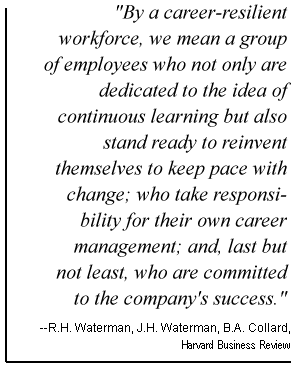
Employees have a stake in sharing the
responsibility with the manager for learning. They are beginning to
realize the need for career resilience, that is, for staying on the
cutting edge in their fields if they want to be marketable and stay
productive.
Employees are also recognizing the value of being multiskilled, particularly in the downsized, streamlined environment of today's government. With multiple skills, not only do they have more value in the positions they hold, they can also move more easily across functional boundaries and to different assignments as workloads shift.
Managers can increase employees' awareness of how important it is to update their skills and do whatever it takes to provide value to the organization. This understanding comes when employees become more knowledgeable of business management practices and are treated as trusted members of the team.
You can expect motivated employees to:
- lead work teams, work projects, and cross-functional teams;
- write their own individual development plans, set goals for
themselves, and define the steps they must take to meet those
goals;
- seek out training and development programs and assignments they know
they need to progress in their careers;
- read books, magazines, and journals that address current issues or
needs of the organization, and look for opportunities to apply what they
learn;
- serve as coaches, counselors, and mentors to less senior colleagues;
and
- identify problems that can be solved with organizational learning
strategies.
 Managers can promote and promulgate these behaviors by creating
an environment in which employees feel secure in making suggestions and by
rewarding employees who aggressively seek out learning opportunities for
themselves and their organization.
Managers can promote and promulgate these behaviors by creating
an environment in which employees feel secure in making suggestions and by
rewarding employees who aggressively seek out learning opportunities for
themselves and their organization.
All employees have a need for lifelong learning, and when they are convinced of the benefits that can be derived from workplace learning activities, they will be enthusiastic helpers and participants in the process.
Executive Leaders as a Source of
Support
Executive leaders must support and recognize
your learning initiatives, build the infrastructure, and create a climate
conducive to performance and growth. They support their managers by:
- encouraging work across organizational boundaries;
- rewarding your efforts to experiment and innovate;
- recognizing learning initiatives that produce results; and
- engaging in open, continuous interchange of ideas and
information.
Executive leaders can build the all-important infrastructure in the organization to sustain continuous learning by:
- making reference to learning and human capital as part of the
organization mission, vision, and values statement;
- identifying the core competencies of the organization;
institutionalizing a process, which includes the HRD office, to
integrate the organization's business strategy with its human capital
plan;
- making major investments in training and development that support
strategic objectives;
- creating an organizationwide learning council that oversees the
organization's priorities for growth, investment, change, and
performance;
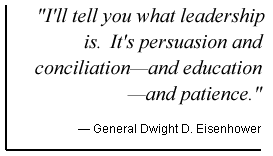 developing policy to preserve or increase investment in human
capital during downturns;
developing policy to preserve or increase investment in human
capital during downturns;
- establishing performance management systems that reward managers and
employees for achieving learning goals;
- designing flexible structures and processes that facilitate
integrated learning in different organizational subsets;
- installing systems to measure the effectiveness of training related
to organizational performance indicators;
- funding technology that facilitates communication and learning
across organizational boundaries; and
- staffing the HRD function with specialists who can support
managers.
Executive leaders can strengthen organizational performance and growth by:
- promoting a climate of openness and truth,
- placing a high value on the generation and rapid dissemination of
knowledge,
- rewarding learning through performance systems from the top down,
and
- sharing ownership of results.
HRD Offices as a
Source of Support
The HRD office and its staff of HRD
professionals should be a valuable resource for every facet of learning.
 Some agency HRD offices, however, are still working to
acquire the new competencies and capabilities needed to provide you with
learning services. They are in a state of transition, moving from a world
made up exclusively of traditional training programs to a new world where
training is just one of several modes of learning.
Some agency HRD offices, however, are still working to
acquire the new competencies and capabilities needed to provide you with
learning services. They are in a state of transition, moving from a world
made up exclusively of traditional training programs to a new world where
training is just one of several modes of learning.
The HRD community is reinventing itself to play new, valuable roles in the organization. For example, when learning moves from the classroom into the workplace, HRD professionals become learning facilitators and advisors to managers. Instead of being in charge of the classroom, HRD professionals are in service to the workplace. They play a strategic role in linking learning to the organization's performance goals. They serve as the protectors and developers of the core competencies of the organization. They thus must understand the business of that organization.
In the reinvented HRD office, HRD professionals are consultants on
organizational change and performance interventions. They know how to
develop formal and informal learning activities, and have a good command
of new learning tools and technology.  They can facilitate work teams, create mechanisms for sharing
learning, and assess the value of learning initiatives. They can structure
competency-based career systems and needs assessment tools that enable
employees to develop along career paths that enhance their contribution to
the organization. All the while, these HRD practitioners continue to
ensure that the major learning programs throughout the organization follow
a standardized instructional systems development process and are linked to
organizational goals and outcomes.
They can facilitate work teams, create mechanisms for sharing
learning, and assess the value of learning initiatives. They can structure
competency-based career systems and needs assessment tools that enable
employees to develop along career paths that enhance their contribution to
the organization. All the while, these HRD practitioners continue to
ensure that the major learning programs throughout the organization follow
a standardized instructional systems development process and are linked to
organizational goals and outcomes.
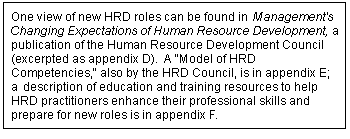 The HRD profession has changed because the whole notion of
learning has shifted, technology has advanced, and jobs have evolved. It
is not surprising that people in the HRD field are highly concerned about
developing new competencies of their own and obtaining more training to
increase their expertise. They must be proficient in new instructional
technologies, team learning strategies, cost benefit analysis, and
organizational performance outcome measures, to name but a few of the
requisite competencies in the field. In sum, then, the HRD office provides
support in:
The HRD profession has changed because the whole notion of
learning has shifted, technology has advanced, and jobs have evolved. It
is not surprising that people in the HRD field are highly concerned about
developing new competencies of their own and obtaining more training to
increase their expertise. They must be proficient in new instructional
technologies, team learning strategies, cost benefit analysis, and
organizational performance outcome measures, to name but a few of the
requisite competencies in the field. In sum, then, the HRD office provides
support in:
- planning,
- estimating costs,
- selecting,
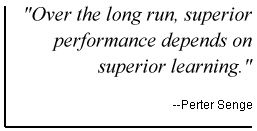
- designing,
- developing,
- procuring,
- conducting, and
- evaluating
learning at every level of the organization.
Outsourcing and Collaborating
The recent
emphasis on downsizing the federal payroll has made contracting out for
services a very appealing prospect. While it is not a panacea, outsourcing
is frequently a highly useful mechanism. But managers need to keep in mind
that when they contract out for training — whether for the design,
development, implementation, administration, or evaluation of training —
they are contracting out the work, not the accountability.
 Consequently, managers need to plan carefully and factor the
time and costs of managing the resulting contract. The goal should be to
reduce costs, improve productivity, and maintain or develop the capability
to respond to emerging requirements. An effort should be made, too, to
concentrate on retaining core business competencies and outsourcing those
functions that are readily available from external sources.
Consequently, managers need to plan carefully and factor the
time and costs of managing the resulting contract. The goal should be to
reduce costs, improve productivity, and maintain or develop the capability
to respond to emerging requirements. An effort should be made, too, to
concentrate on retaining core business competencies and outsourcing those
functions that are readily available from external sources.
Successful outsourcing depends on close attention to contract requirements, good communication with vendors, and careful oversight of contract performance. When determining whether to perform work in-house or outsource it, follow a solid business model. Cost should not always be the determining factor. At a minimum, consider the following:
- Off-the-shelf vs. unique product — If this is a need common
to many organizations, it is probably cheaper to outsource. In the case
of a unique requirement, the answer may not be so simple.
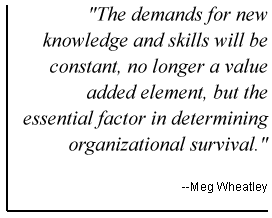 Recurring vs. one-time requirement — If this is going
to be a long-term requirement, it might be advantageous to develop the
capability to do it in- house. Consider outsourcing pieces or have a
contractor train in-house personnel to perform the work.
Recurring vs. one-time requirement — If this is going
to be a long-term requirement, it might be advantageous to develop the
capability to do it in- house. Consider outsourcing pieces or have a
contractor train in-house personnel to perform the work.
- Size and capability of in-house resources — Can existing
staff do the work without costly retraining? Can personnel be added or
detailed from other organizations?
Many organizations have arrangements with colleges and universities to deliver courses on- site, either with local faculty or through satellite networks. These arrangements have enhanced learning value because faculty gain knowledge about the agency, and employees build networks and alliances that endure back on the job.
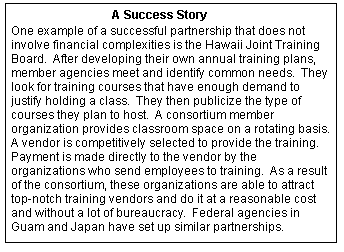 Explore the possibility of partnering with one or more
organizations that have the same need. This approach is particularly
useful when training is needed but there are not enough employees to
justify holding a class. Various types of partnerships exist. some are
very formalized and involve complex arrangements; others can be quite
simple.
Explore the possibility of partnering with one or more
organizations that have the same need. This approach is particularly
useful when training is needed but there are not enough employees to
justify holding a class. Various types of partnerships exist. some are
very formalized and involve complex arrangements; others can be quite
simple.
Using the
Ideas of Others
In the pressured environment in which
most government managers find themselves, the need for effective responses
to organizational challenges is constant. Need a new training program for
your employees in two weeks? Want to develop a mentoring initiative ASAP?
Or a strategic plan by the end of the month?
The time and resources to develop responses are limited, but managers rise to the challenge every day. Often, the successes of others can be adopted or adapted to your needs, saving time, effort, and money. The objective is accessing what other agencies have accomplished in terms of policies, programs, products, and experience. Networking is the key. The media for this networking range from quick phone conversations to surfing the Web for the right home page to attending a professional society's monthly meeting.
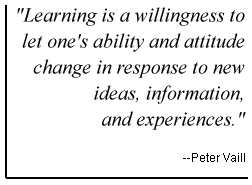 The HRD office in your organization should maintain contacts
with sister HRD offices in other agencies. In addition, encouraging your
own staff to participate in professional activities—and doing so
yourself—to meet colleagues in government and the private sector is an
investment likely to pay substantial returns.
The HRD office in your organization should maintain contacts
with sister HRD offices in other agencies. In addition, encouraging your
own staff to participate in professional activities—and doing so
yourself—to meet colleagues in government and the private sector is an
investment likely to pay substantial returns.
Sample Policies, Programs, and Products
 The resources within the government community are vast. And,
best of all, excellent advice, ideas, and resources are free. Following
are examples of policies, programs, and products developed by various
federal agencies that could be useful to you and your organization. Bear
in mind that this is only a sampling, and there are many more examples out
there. Also, various bulletin boards and on- line services can get you and
your staff quick access to new, useful information and networks.
The resources within the government community are vast. And,
best of all, excellent advice, ideas, and resources are free. Following
are examples of policies, programs, and products developed by various
federal agencies that could be useful to you and your organization. Bear
in mind that this is only a sampling, and there are many more examples out
there. Also, various bulletin boards and on- line services can get you and
your staff quick access to new, useful information and networks.
- National Instructor System — The Bureau of Alcohol, Tobacco,
and Firearms, Instructor Systems Branch, has an accredited instructor
training program open to colleagues in other public service agencies.
Attendees learn how to develop, deliver, and administer training in
workgroups and in the classroom.
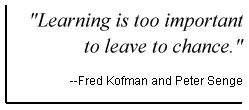 Bartered Consultant Services — The Federal Aviation
Administration (FAA), Human Resources Services Division, Great Lakes
Region, shares its expertise in reengineering, self-managed teams,
benchmarking, automation, training, etc., in return for consultant and
training services from other agencies and FAA regions.
Bartered Consultant Services — The Federal Aviation
Administration (FAA), Human Resources Services Division, Great Lakes
Region, shares its expertise in reengineering, self-managed teams,
benchmarking, automation, training, etc., in return for consultant and
training services from other agencies and FAA regions.
- Process Consultation — Organizational development consultants
in FAA's Great Lakes Region observe managers and/or teams as they hold
meetings. Their role is to help assess strengths and weaknesses, and
determine how to effect positive change.
- Mentoring Program — The Training Academy of the Department of
Housing and Urban Development pairs voluntary mentors and employees;
training is provided for both parties, and a memorandum of understanding
is provided to clarify responsibilities in the mentoring relationship
and ensure career enhancement.
- Curriculum for Change — This Department of Transportation HRD
effort is a comprehensive curriculum for change management with a
three-tier learning and development framework: (1) dynamics of
transformation, (2) assessment against desired performance dimensions,
and (3) individual learning and development opportunities for nine
critical elements. The curriculum is used to prepare employees for
changes in the work environment as a result of reengineering and
downsizing.
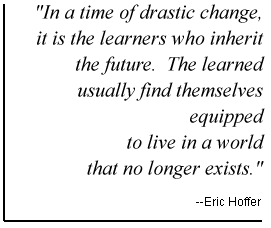 Quality of Worklife Strategy — This
comprehensive strategy from Health and Human Services was developed at
the Department level in response to concerns about employee commitment
and morale during a period of tremendous change and uncertainty. The
strategy has three objectives: (1) increase employee satisfaction, (2)
strengthen workplace learning, and (3) better manage ongoing change and
transition. The strategy includes a wide range of initiatives to improve
communications, become a learning organization, and promote family-
friendly workplace programs.
Quality of Worklife Strategy — This
comprehensive strategy from Health and Human Services was developed at
the Department level in response to concerns about employee commitment
and morale during a period of tremendous change and uncertainty. The
strategy has three objectives: (1) increase employee satisfaction, (2)
strengthen workplace learning, and (3) better manage ongoing change and
transition. The strategy includes a wide range of initiatives to improve
communications, become a learning organization, and promote family-
friendly workplace programs.
- Action Work-Outs — The U.S. Air Combat Command (ACC) uses the
work-out technique pioneered by GE to rapidly reengineer its work
processes. (Work-outs are a form of organizational learning described in
Getting Better Results.) In "Action Work-Outs," teams of ACC employees
are assigned to analyze their work processes within one week's time and
to present their recommendations for change to top managers. Their
changes helped ACC set new records for efficiency — for example,
slashing the time it takes to inspect B1-B bombers by 42 percent, and
cutting in half the time it takes to get F-15 fighter jets ready for
combat.24
- Mentoring Handbook — The Department of the Navy developed a
comprehensive handbook to support its agencywide mentoring program.
Developed by a workgroup of the Navy Civilian Leadership Board, the
handbook covers: (1) questions and answers about mentoring, (2) the
stages of mentoring, and (3) building mentoring skills. The handbook is
part of a training program provided to all mentors and
employees.
- Training Policy Handbook: Authorities and Guidelines — This
Office of Personnel Management publication covers essential legal
information managers and practitioners need in making decisions about
establishing, funding, implementing and evaluating HRD programs. Easy to
read, it summarizes the legal foundation of training and provides legal
references by topic area.
- TEAM Handbook — This Department of Education publication was
developed to help employees understand teams and move to a team-based
structure. Managers use it to decide whether to establish teams and as a
guide for effectively overseeing and developing teams. Employees use it
to understand the different types of teams and team dynamics.
- Human Resources Strategic Planning — The Defense Information
Systems Agency (DISA) has developed a Human Resources Strategic Plan.
Through this process, key human resource imperatives were identified
that were aligned with DISA's mission and corporate goals. The document
serves as a roadmap for the organization and provides a clear rationale
as to why human resource programs exist, and how they relate to the
vision and mission of the organization. The plan allowed DISA to set
priorities for training across the organization and assign resources
accordingly.
- DOT Connection — This one-stop customer service center was
created by consolidating three different centers that provide service to
the entire Department of Transportation. The center offers a variety of
employment, career development, and worklife services to help balance
work and personal responsibilities. These services help managers and
employees gain the tools they need to enhance their development and
benefit their organization. Other federal agencies can take advantage of
these services on a fee basis.
- PTO University — The Patent and Trademark Office (PTO) has
partnered with several local colleges and universities to provide a
series of academic programs designed for PTO employees. All courses are
funded by the agency, held at the agency's offices, and aim to help
employees in future career paths at PTO. Counseling, tutoring, and peer
assistance programs are available to all students.
Federal Learning Technology Resources
Technology can increase the power and efficiency of learning many times over. Satellite networks can broadcast across great distances, bringing top experts into the workplace for just-in-time training. Computer-based instruction sits resident at employee workstations until it is needed. While technology requires a large upfront investment, the payoffs to management are well-documented. Many federal organizations have made major investments in technology and have created centers of excellence. You will find them very willing to share their lessons learned and—very often—their resources as well. Here are some examples of agencies' technology-based delivery systems.